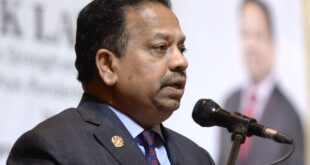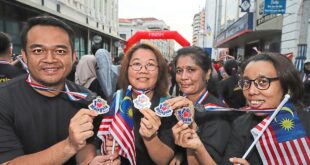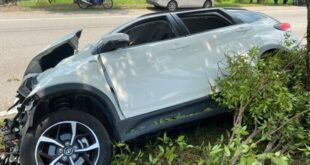DRAGONfruit farms are sprouting in Sepang, with farmers enjoying good returns.
They are also producing by-products as a way to salvage overripe fruits.
Sepang Agriculture Office statistics show that many landowners in the southern Selangor district are transforming their land into dragonfruit farms.
The fruit, however, is not native to Malaysia. It originated from Mexico, Central America and South America.
Tourists taking snapshot in front of a dragonfruit sculpture at HL Dragon Fruit Eco Farm in Sepang. — Photos: AZHAR MAHFOF & LOW BOON TAT/The Star
It was first planted in Malaysia over 20 years ago.
Sepang district agricultural office deputy director Rozman Sumiati said dragonfruit, also called pittaya among locals, was first planted in the late 1990s.
He said dragonfruit was the preferred choice among fruit farmers due to its quick return on investment.
He explained that the trees would start bearing fruit from the eighth month and throughout the year.
“Due to its scarcity back then, the fruit fetched a high price.
“The first variety planted had red skin and white flesh.”
Seeing the success of the first few dragonfruit farms, he said more landowners were jumping on the bandwagon. As such, the Agricultural Department has stepped in to assist.
“In 2002, more farmers planted dragonfruit trees, but this time many planted the red skin and red flesh variety from seeds imported from Thailand and Taiwan, which were much sweeter and a hit among locals,” he added.
However, not everything was rosy for the farmers.
Rozman recalled the period between 2007 and 2010 when many dragonfruit farms were forced to close due to the Anthracnose disease that caused tree stems to rot. But some farmers persevered.
“Today, there are 181.45ha of dragonfruit farms.
“Between January and September this year, 12.4 million kilogrammes of the fruit were produced valued at RM49.9mil.
“This was despite a major flood at the end of last year which reduced supply at the beginning of this year,” he said.
Diverse uses
Sepang Dragon Fruit Association deputy chairman Sam Chia said the farms in Sepang have now become tourist attractions too.
Many tour packages in Sepang include visits to the farms as people want to know how the fruit is grown, he noted.
Chia showing a mature dragonfruit ripe for the picking.
He said many visitors expressed surprise that dragonfruits were from a climbing plant in the cacti family.
“Many are also unaware of the number of varieties that exist,” he said, adding that there are four varieties of dragonfruits in the market.
They are the Red Ruby, Pink Ruby, Yellow King, and Honey White.
Sepang is the only place in Malaysia where one can find all the varieties, said Chia.
“Widely available is the Red Ruby, which is also the favourite due to its attractive colour and sweet taste.
“It is the highest yielding variant too, and has become farmers’ preferred choice to plant,” he said.
Dragonfruits and its various by-products such as snacks and drinks are sold by some farms in Sepang.
Chia is also the founder of Hong Long International Group Sdn Bhd that manages the HL Dragon Fruit Eco Farm, which is open to visitors.
His farm receives up to 3,000 visitors on weekends.
He also runs a restaurant that serves dragonfruit-infused food and drinks.
“The dragonfruit does not have a strong taste, but the red flesh is very attractive.
“Our chef experimented with many recipes and has come up with food such as nasi lemak, buns and a seafood dish.
“We also have dehydrated dragonfruit slices and a ready-to-eat sambal made from the flower of dragonfruit trees, which many mistake for onion bulbs,” he said.
Another dragonfruit farm owner, Alexis Ooh, plans to create dragonfruit by-products to avoid wastage.
Many roadside stalls can be seen selling the fruit in Sepang, where it is largely grown.
The My Nature Leisure Farm founder said tonnes of fruits had to be thrown away during the Covid-19 movement control order.
“So, I tried to make a dragonfruit concentrate for use in cooking.
“I also freeze-dried dragonfruit to be eaten as a snack.
“I am in the midst of trying to market the products,” she said, adding that her farm is also a resort.
“I offer accommodation with event space and leisure activities that include a sharing session on dragonfruit farming,” said Ooh.
Many food entrepreneurs in Sepang and its surrounding areas also include the fruit in their menu.
One of them is AR Global Trading founder Anwar Mirza Mahmood, who has been running a popsicle business for the last five years.
Anwar (left) and Rozman holding up the dragonfruit popsicles.
He added dragonfruit to his product line this year.
“We have two varieties, one with cream and one without.
“For now, we are distributing to surrounding retailers and are recording sales of up to 10,000 dragonfruit-flavoured popsicles monthly.
“The popsicles are made with more than 80% fruit puree,” said Anwar.
Similarly, Chop Kuan Kee Sdn Bhd managing director Jerrine Teo has found a recipe incorporating dragonfruit in the company’s signature coffee.
The third-generation establishment that started with her grandfather’s coffee processing factory in the 1940s and evolved to include the roasting business after her father took over, has now expanded to include a cafe run by Teo and her two sisters.
One of the drinks in the cafe’s menu is Dragon Fruit Coffee.
It tasted like regular iced coffee but with additional crunch and texture, as the puree was chunky.
“It is the first in Malaysia. We wanted to incorporate the fruit, which is famous in this district, in our signature coffee,” said Teo.
Sungai Pelek Pusat Wanita Berdaya, a state programme to empower women, experimented making kuih bangkit with dragonfruit.
Its coordinator Gomathi Subramaniam said it tasted good and they were trying to promote it at events as a prospective business opportunity for women.
A factory that cleans and packs dragonfruits for export.
Supply and demand
With the growing number of dragonfruit farms, Rozman said the challenge was to ensure there was demand for the fruit, especially during the peak season, which is between July and September.
“The yield is four times higher during the peak season and it is sold cheap during that time.”
He said farm price for the common varieties − Red Ruby and Honey White − could be as low as RM1 per kilogramme from the usual RM6 per kilogramme at off-peak time.
“The market price is usually twice or three times higher,” said Rozman.
He said the fruit could only last a maximum of two weeks without washing and coating.
“We need to make sure small-time farmers can sustain themselves during tough times,” he said.
Rozman hoped to create continuous demand for the fruit and prevent the unsold ones from going to waste.
The department, he said, had engaged with entrepreneurs to innovate new products from the fruit to prevent wastage due to rotting fruits.
“We are also trying to boost the export market.
“For now, we are exporting to Hong Kong, Taiwan, China, Singapore, Dubai in the United Arab Emirates, and some countries in the African continent.
“One factory started operations last year to provide cleaning, coating and packing services to keep the fruits fresh for a longer time, hence enabling farmers to export their harvests,” said Rozman.
“There is also research and development taking place to make biofertiliser, enzyme and beauty products − among others − from dragonfruits.
“This is to ensure demand for the fruit continues to grow in tandem with the increase in farming activities,” he added.
 BeritaKini.biz Berita Viral Terkini di Malaysia
BeritaKini.biz Berita Viral Terkini di Malaysia





